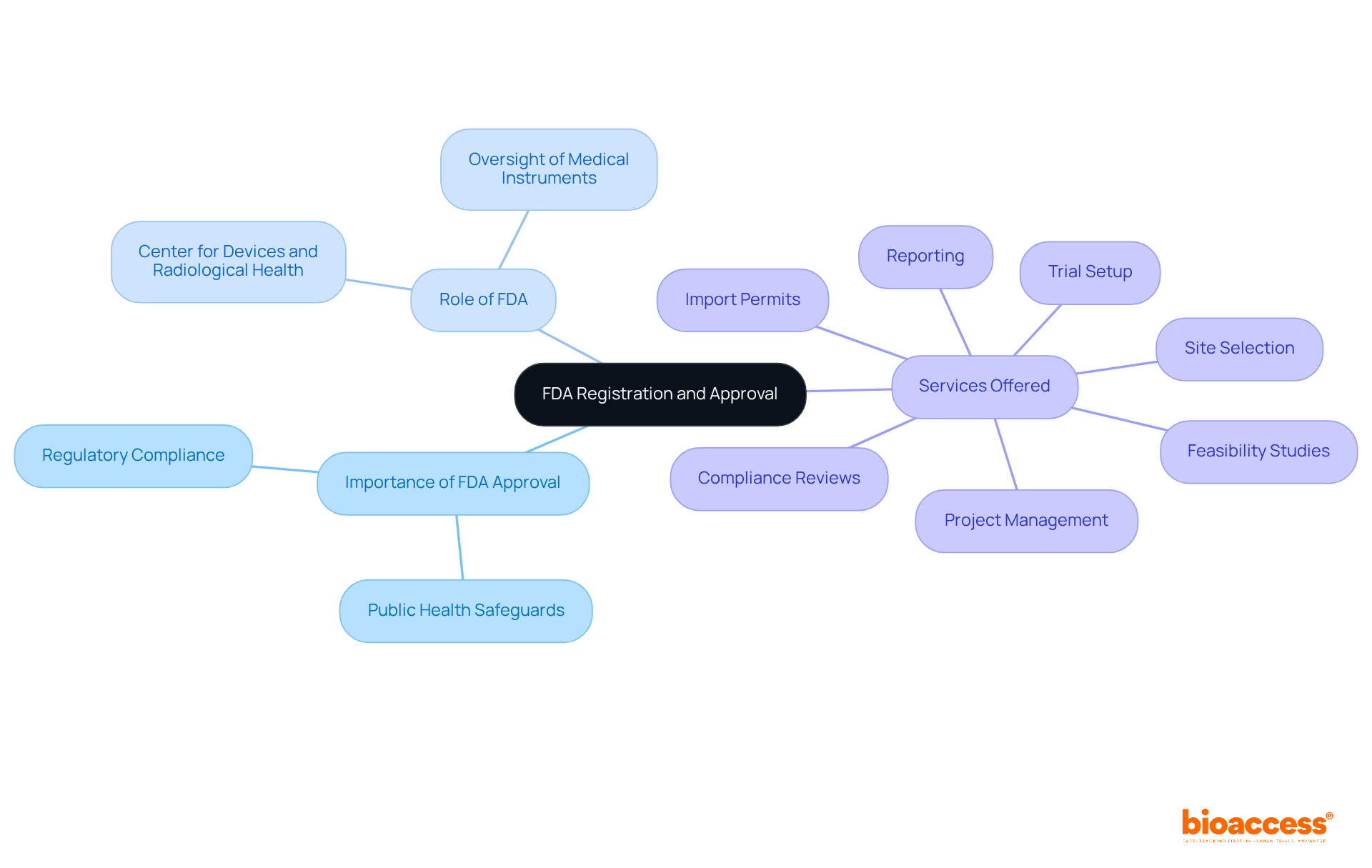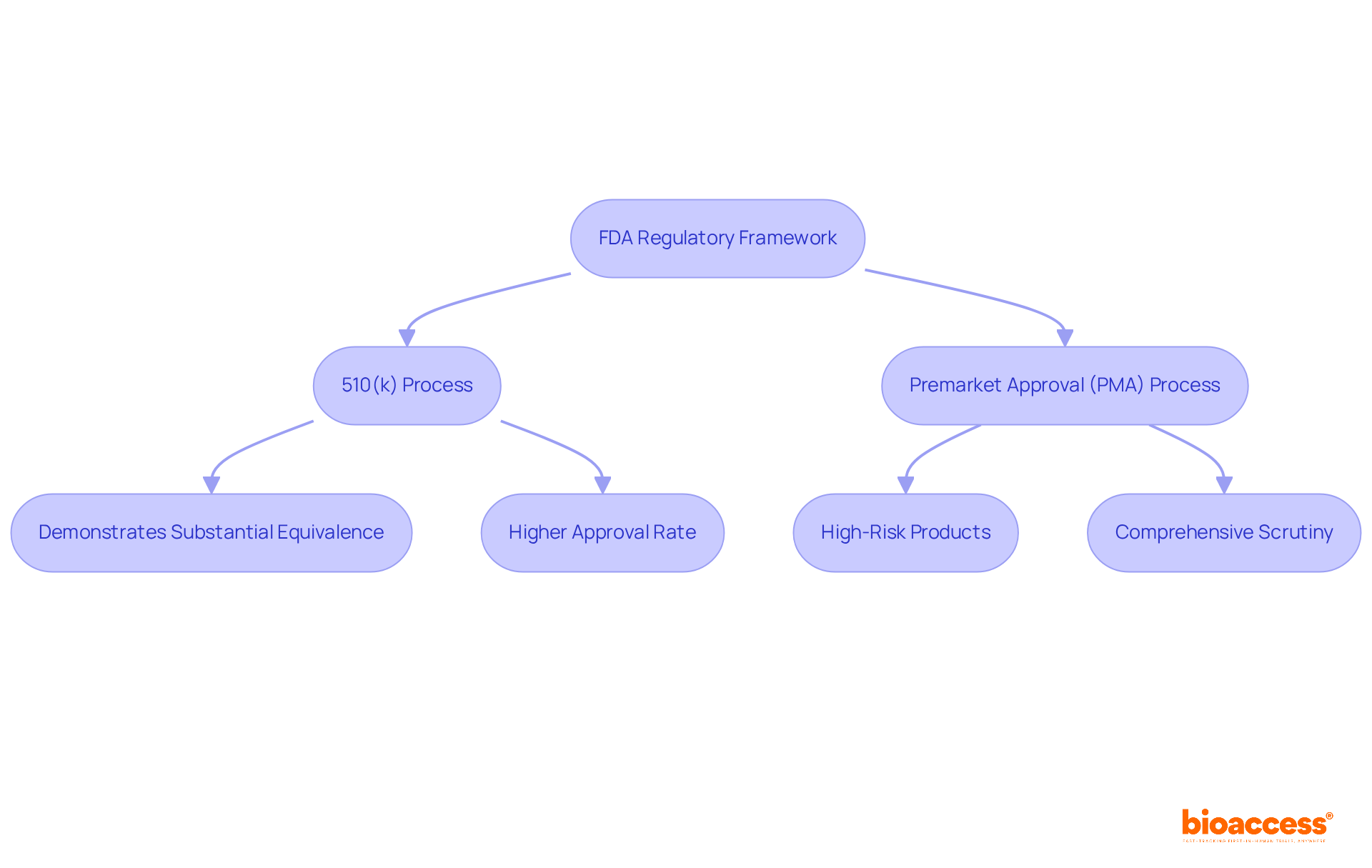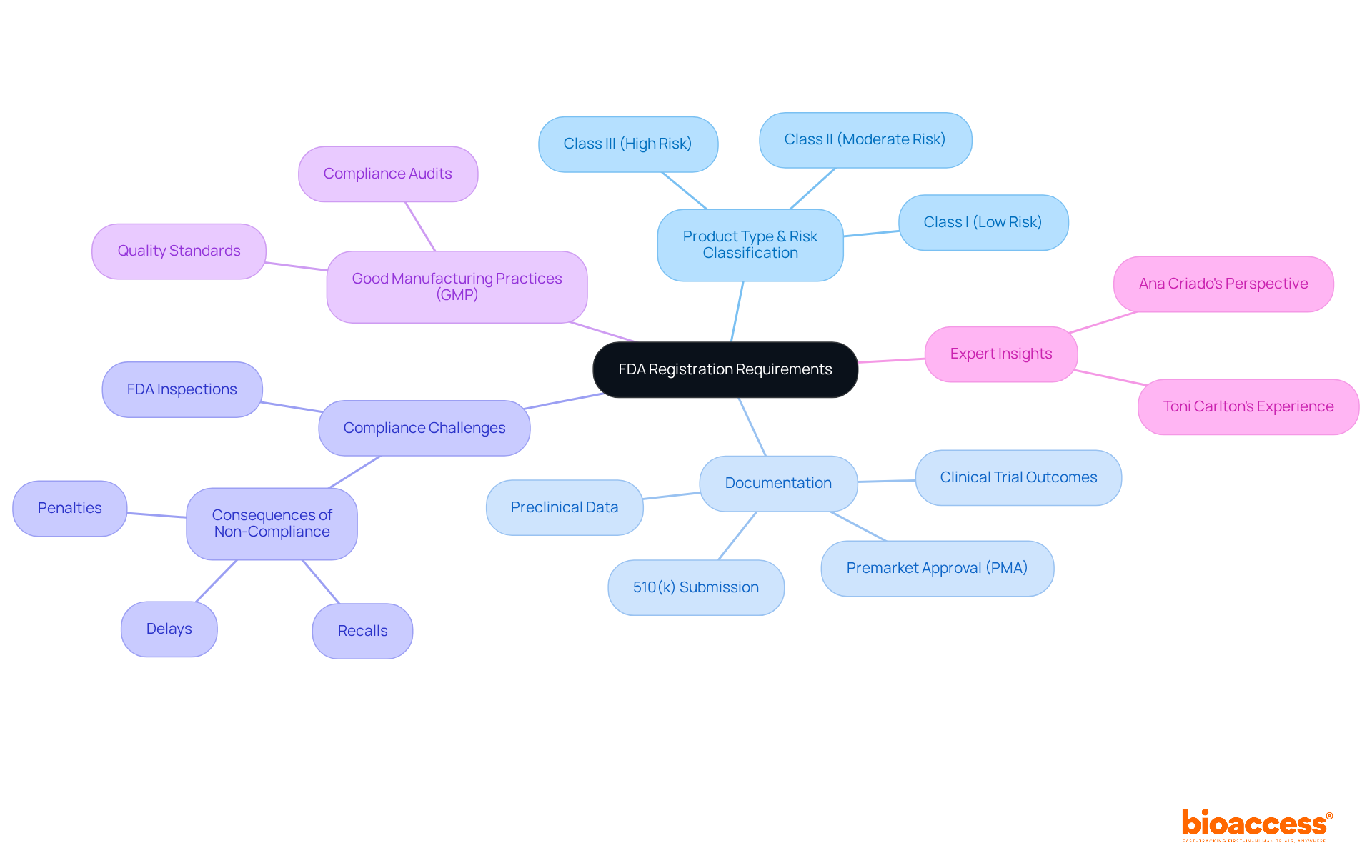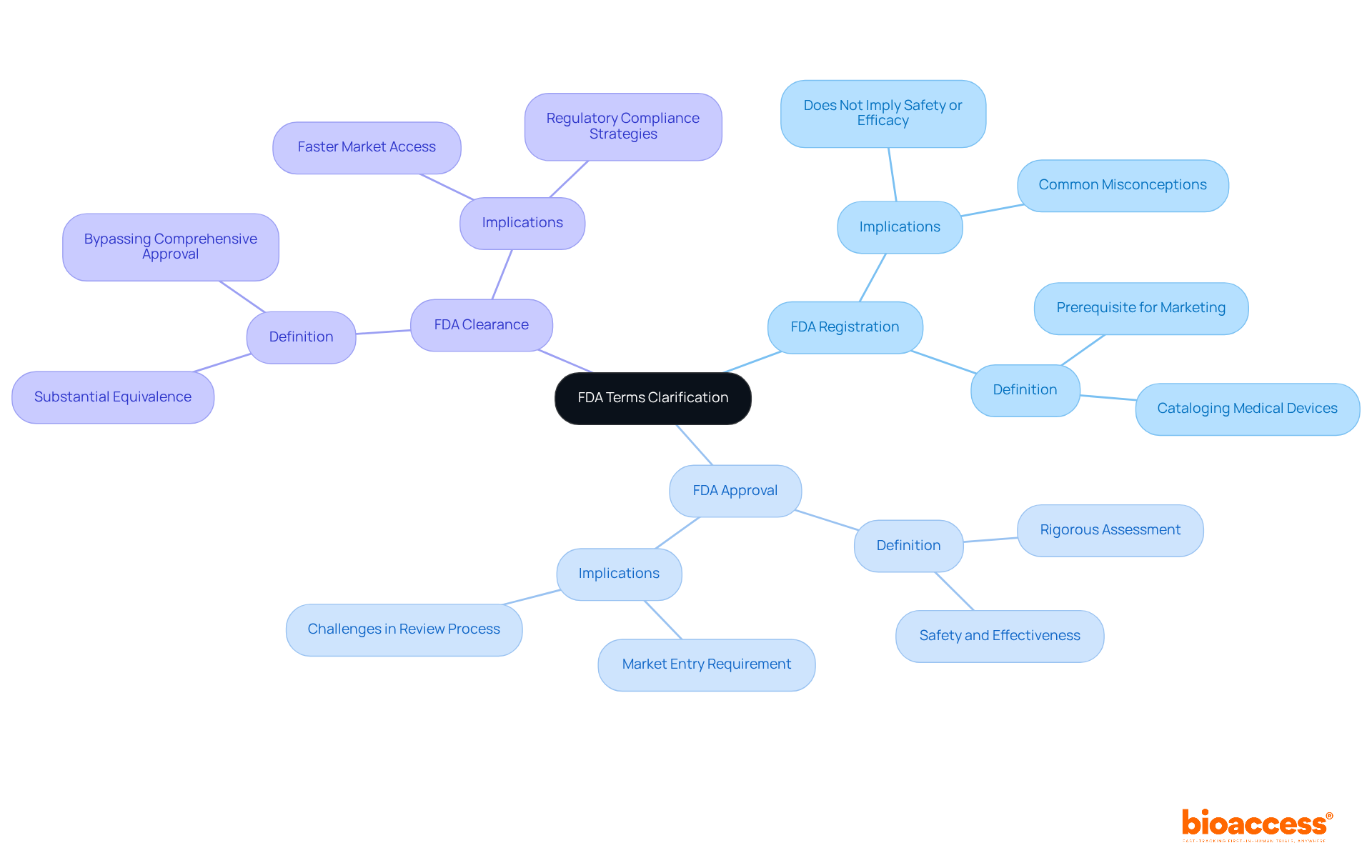


The term "FDA registered" signifies the process of cataloging a medical device with the U.S. Food and Drug Administration. This registration is essential for marketing purposes; however, it does not imply any endorsement regarding the safety or efficacy of the device.
Understanding this distinction is crucial for stakeholders in clinical research, as it underscores the differences between FDA registration, approval, and clearance. This knowledge is vital for ensuring regulatory compliance and formulating effective market strategies.
Understanding the intricacies of FDA registration is crucial for anyone involved in clinical research and the medical industry. This process not only verifies that products meet stringent safety and efficacy standards but also plays a pivotal role in ensuring public health. As stakeholders navigate the complex landscape of regulatory compliance, a pressing question arises: how can a clear grasp of what it means to be FDA registered empower researchers and innovators to streamline their paths to market while avoiding common pitfalls?
FDA approval represents a critical process through which medical devices, pharmaceuticals, and related items are submitted to the U.S. Food and Drug Administration (FDA) for thorough assessment. This process ensures that products meet rigorous safety and efficacy standards before they can enter the market. For companies aiming to conduct clinical studies or introduce new offerings, securing FDA approval is essential, as it verifies compliance with federal regulations.
Beyond mere adherence, FDA approval plays a vital role in safeguarding public health by confirming that products are safe for consumer use and effective for their intended purposes. Without this approval, products are prohibited from entering the U.S. market, underscoring its significance for innovators in the Medtech and Biopharma sectors. Furthermore, the FDA oversees more than 190,000 unique medical instruments, making the approval process intricate and crucial for maintaining high standards in healthcare provision. The FDA's Center for Devices and Radiological Health (CDRH) governs this regulatory framework, ensuring that devices meet the necessary criteria.
At bioaccess, we provide comprehensive clinical trial management services designed to simplify the FDA approval process. Our offerings encompass:
These services are strategically crafted to accelerate clinical trials, enabling Medtech, Biopharma, and Radiopharma startups to efficiently navigate the complexities of regulatory approval. Understanding what does FDA registered mean is critical when distinguishing between FDA Listed and FDA Approved; while listing confirms that an item can be marketed, approval is mandatory for specific items to ensure they meet additional safety and efficacy standards. Non-compliance can result in corrective actions by the FDA, further highlighting the necessity of adhering to these regulations.

The FDA operates within a robust regulatory framework that ensures the safety and efficacy of medical products. This structure encompasses various approval pathways, including the 510(k) process, which allows products to gain authorization by demonstrating substantial equivalence to existing devices, and the Premarket Approval (PMA) process, reserved for high-risk products requiring more comprehensive scrutiny. Understanding what does FDA registered mean is important, as it transcends mere regulatory compliance; it establishes a standard for quality assurance and fosters trust among healthcare providers and patients alike. For clinical researchers, understanding this framework is essential, as it delineates the prerequisites for conducting studies and obtaining necessary approvals.
This comprehension directly influences the speed and success of product development, with studies revealing that devices utilizing the 510(k) pathway enjoy a markedly higher approval rate than those undergoing PMA. Successful case studies, such as the De Novo classification of the IDx-DR software for diabetic retinopathy detection, illustrate how effectively navigating these pathways can result in timely market entry and improved patient outcomes. Furthermore, bioaccess® provides critical services, including review and feedback on study documents, compliance assessments, trial setup, import permits, project management, and reporting on serious and non-serious adverse events. These services are vital for overcoming regulatory challenges.
Thus, understanding what does FDA registered mean is essential, as it is not merely a regulatory obstacle but a crucial element of the clinical research landscape that can expedite innovation and enhance healthcare delivery.

FDA registration requirements are contingent upon the product type and its associated risk classification. Companies are mandated to furnish comprehensive documentation, which includes preclinical data, clinical trial outcomes, and detailed manufacturing processes. For medical instruments, the FDA typically necessitates either a 510(k) submission or a Premarket Approval (PMA) application, depending on whether the instrument is classified as low, moderate, or high risk. Notably, the 510(k) pathway is the most frequently utilized, with 82% of devices cleared or approved through this route in 2017, underscoring its significance within the regulatory framework.
Adherence to Good Manufacturing Practices (GMP) is essential to ensure that products are consistently produced and regulated in accordance with established quality standards. This compliance is crucial for maintaining the integrity and safety of the product. Manufacturers face compliance challenges in navigating the complexities of FDA regulations, which can lead to delays, penalties, or recalls if not managed properly. The FDA conducts inspections to evaluate compliance with GMP, and any deviations may result in corrective actions that could impede market entry.
Understanding what does FDA registered mean is essential for both clinical researchers and companies. Non-compliance can have a profound impact on patient safety and the overall success of medical innovations, making it imperative to prioritize adherence to FDA standards throughout the product development lifecycle. Comprehensive clinical trial management services—including feasibility studies, site selection, compliance reviews, trial setup, import permits, project management, and reporting—are essential components in effectively navigating these regulatory landscapes. Experts such as Ana Criado, Director of Regulatory Affairs and CEO of Mahu Pharma, emphasize the importance of thorough compliance in the context of both FDA regulations and local authorities like INVIMA in Colombia.

Misunderstandings surrounding FDA certification are prevalent, particularly when distinguishing it from FDA approval and clearance. FDA registration pertains to the procedure of cataloging a medical apparatus with the FDA, which is a prerequisite for marketing but does not suggest endorsement of safety or efficacy. In contrast, FDA approval entails a rigorous assessment of an item’s safety and effectiveness prior to its market entry. FDA clearance pertains to devices that show substantial equivalence to current items, enabling them to circumvent the more comprehensive approval process.
These distinctions are vital for stakeholders in clinical research, as they influence regulatory compliance and market strategies. A common misconception is that FDA registration means the same thing as what does fda registered mean, which can lead to misinformed decisions regarding product development and marketing. Experts like Ana Criado, Director of Regulatory Affairs and CEO of Mahu Pharma, emphasize the importance of understanding these terms, especially in the context of cannabis regulation in Colombia. Additionally, Katherine Ruiz, an expert in Regulatory Affairs for Medical Devices and In Vitro Diagnostics in Colombia, provides valuable insights into navigating these complexities.
A case study highlighting the FDA's Diversity Action Plan illustrates the importance of understanding these terms; sponsors who fail to grasp the nuances may face challenges during the review process, potentially incurring additional costs and delays. As noted by Nora, "The FDA’s job is to protect patients and help bring safe, effective treatments to market," underscoring the critical nature of compliance.
Clarifying these terms not only aids in navigating the regulatory landscape but also empowers companies to align their strategies with compliance requirements. By fostering a deeper understanding of FDA terminology, stakeholders can enhance their operational efficiency and ensure a smoother path to market.

Understanding the significance of FDA registration is crucial in the realm of clinical research and product development. It transcends mere regulatory formality, serving as a foundational element that ensures medical devices and pharmaceuticals meet stringent safety and efficacy standards before they reach the market. This rigorous process not only facilitates compliance with federal regulations but also protects public health, reinforcing the importance of FDA approval in fostering trust among healthcare providers and patients.
The article delves into the complexities of the FDA approval process, highlighting key pathways such as the 510(k) and Premarket Approval (PMA) processes. It emphasizes the necessity for thorough documentation and adherence to Good Manufacturing Practices (GMP) to navigate these regulatory landscapes successfully. By clarifying common misconceptions surrounding FDA registration, approval, and clearance, stakeholders can better align their strategies with compliance requirements, ultimately enhancing their operational efficiency.
In light of these insights, it is imperative for companies and researchers to prioritize understanding FDA registration and its implications. This knowledge not only expedites innovation but also plays a vital role in improving healthcare outcomes. Engaging with comprehensive clinical trial management services can further streamline the journey through the regulatory maze, ensuring that medical innovations can safely and effectively reach those who need them most.
What is FDA registration?
FDA registration refers to the process through which medical devices, pharmaceuticals, and related items are submitted to the U.S. Food and Drug Administration (FDA) for thorough assessment to ensure they meet safety and efficacy standards before entering the market.
Why is FDA approval important?
FDA approval is essential for companies to conduct clinical studies or introduce new products, as it verifies compliance with federal regulations and safeguards public health by confirming that products are safe for consumer use and effective for their intended purposes.
What happens if a product does not receive FDA approval?
Products that do not receive FDA approval are prohibited from entering the U.S. market, emphasizing the significance of this process for innovators in the Medtech and Biopharma sectors.
What does the FDA oversee?
The FDA oversees more than 190,000 unique medical instruments, making the approval process intricate and vital for maintaining high standards in healthcare provision.
Which FDA division governs the approval process for medical devices?
The FDA's Center for Devices and Radiological Health (CDRH) governs the regulatory framework for medical devices, ensuring they meet the necessary criteria.
What services does bioaccess provide to assist with the FDA approval process?
Bioaccess provides comprehensive clinical trial management services including feasibility studies, site selection, compliance reviews, trial setup, import permits, project management, and reporting to simplify the FDA approval process.
What is the difference between FDA Listed and FDA Approved?
FDA Listing confirms that an item can be marketed, while FDA Approval is mandatory for specific items to ensure they meet additional safety and efficacy standards.
What are the consequences of non-compliance with FDA regulations?
Non-compliance can result in corrective actions by the FDA, highlighting the necessity of adhering to these regulations.